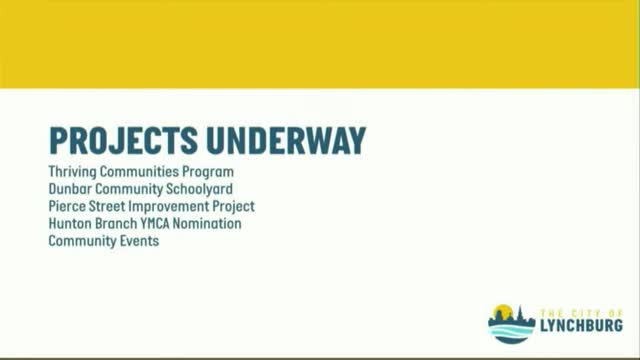City launches ambitious projects to revitalize Diamond Hill community
August 29, 2024 | Lynchburg, Campbell, Virginia
This article was created by AI summarizing key points discussed. AI makes mistakes, so for full details and context, please refer to the video of the full meeting. Please report any errors so we can fix them. Report an error »

During a recent government meeting, city officials outlined several key community development projects aimed at enhancing local infrastructure and public spaces. The discussions highlighted initiatives under the Thriving Communities Program, which is a collaboration between the Central Virginia Planning District Commission, city staff, and the Greater Lynchburg Transit Company (GLTC). This program, funded by the U.S. Department of Transportation, focuses on planning and technical assistance to support under-resourced communities in advancing transportation and infrastructure projects.
One of the primary focuses is the redevelopment of the 12th Street corridor, which is envisioned as a vibrant, transit-oriented marketplace. This area is strategically located near multiple transit options, including Greyhound, Amtrak, and GLTC services, making it a critical hub for community connectivity. The city plans to work with ABT Global to develop this area further, integrating it into the broader Diamond Hill neighborhood plan.
Additionally, the city council has approved $478,000 for the Dunbar Community Schoolyard project, which aims to transform the school campus into a public green space when not in use by students. This initiative is expected to significantly increase park access for residents in the Diamond Hill and College Hill neighborhoods, with 75% of Diamond Hill residents living within a 10-minute walk of the site.
The meeting also addressed the Pure Street Improvement Project, which will enhance pedestrian safety and aesthetics by establishing a tree lawn on the 1200 block of Pure Street. This project aims to calm traffic and improve the entrance to the Pure Street Renaissance historic district.
Another significant topic was the nomination of the Huntin Branch YMCA to the historic registers. Built in 1956, this facility served as a vital recreation space for Lynchburg's Black community during segregation. The city is collaborating with local organizations and the Virginia Department of Historic Resources to advance this nomination, which is seen as an important step in recognizing the site's historical significance.
Finally, the importance of community events was emphasized as a means to foster neighborhood connections and vibrancy. The planning division recommended that the Diamond Hill Neighborhood Plan be forwarded to the city council for inclusion in the city's comprehensive plan for 2013-2030, marking a significant step towards realizing these community-focused initiatives.
One of the primary focuses is the redevelopment of the 12th Street corridor, which is envisioned as a vibrant, transit-oriented marketplace. This area is strategically located near multiple transit options, including Greyhound, Amtrak, and GLTC services, making it a critical hub for community connectivity. The city plans to work with ABT Global to develop this area further, integrating it into the broader Diamond Hill neighborhood plan.
Additionally, the city council has approved $478,000 for the Dunbar Community Schoolyard project, which aims to transform the school campus into a public green space when not in use by students. This initiative is expected to significantly increase park access for residents in the Diamond Hill and College Hill neighborhoods, with 75% of Diamond Hill residents living within a 10-minute walk of the site.
The meeting also addressed the Pure Street Improvement Project, which will enhance pedestrian safety and aesthetics by establishing a tree lawn on the 1200 block of Pure Street. This project aims to calm traffic and improve the entrance to the Pure Street Renaissance historic district.
Another significant topic was the nomination of the Huntin Branch YMCA to the historic registers. Built in 1956, this facility served as a vital recreation space for Lynchburg's Black community during segregation. The city is collaborating with local organizations and the Virginia Department of Historic Resources to advance this nomination, which is seen as an important step in recognizing the site's historical significance.
Finally, the importance of community events was emphasized as a means to foster neighborhood connections and vibrancy. The planning division recommended that the Diamond Hill Neighborhood Plan be forwarded to the city council for inclusion in the city's comprehensive plan for 2013-2030, marking a significant step towards realizing these community-focused initiatives.
View full meeting
This article is based on a recent meeting—watch the full video and explore the complete transcript for deeper insights into the discussion.
View full meeting
